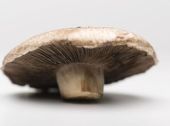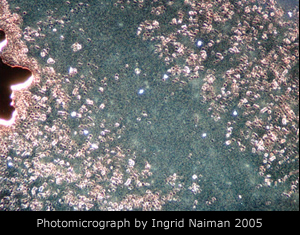 This tale has taken a long time for me to publish. It began innocently enough in a charming town overlooking Lake Maggiore in Switzerland. I was seeing a patient with breast cancer. Her husband was a professor in a major university and was very interested in the microscope. As I was looking at her blood, I was asking lots of questions about where she had traveled, what treatments she had undertaken, etc. Finally, I asked what she had eaten. No one could think of the English word for Steinpilz but with some effort, we determined that she had eaten portobello mushrooms. At this point, her husband was almost too curious for words and he asked if I would look at his blood also, keeping in mind that he was not a patient. It is his blood you see in the flash: Portobello Mushroom Flash. This tale has taken a long time for me to publish. It began innocently enough in a charming town overlooking Lake Maggiore in Switzerland. I was seeing a patient with breast cancer. Her husband was a professor in a major university and was very interested in the microscope. As I was looking at her blood, I was asking lots of questions about where she had traveled, what treatments she had undertaken, etc. Finally, I asked what she had eaten. No one could think of the English word for Steinpilz but with some effort, we determined that she had eaten portobello mushrooms. At this point, her husband was almost too curious for words and he asked if I would look at his blood also, keeping in mind that he was not a patient. It is his blood you see in the flash: Portobello Mushroom Flash.
They came back the next morning, saying they had been talking most the night and both wanted to be checked again. There was significant improvement after taking the herbal antifungal remedy, but they were full of questions, as was I. I waited for a chance to repeat these observations, preferably in multiple ways. For instance, people could eat different kinds of culinary mushrooms, take mushrooms as supplements, or any combination of these efforts.
In the meantime, I talked to colleagues about my theories, going back to Pasteur and some years later Alexander Fleming, but before unraveling the whole story, have a look at the six slides in the presentation.
 Basically, what you see is very rapid lysing of the red blood cells and somewhat alarming disintegration of the neutrophils, clearly visible by the second slide. By the time we get to the fourth slide, you see the survivors trying to escape the plasma. Obviously, this is impossible inside the body, but I have seen it occasionally on slides. Usually, it is observed in samples from people who are on very strong medications. The impression given is that the erythrocytes and white blood cells want to escape and they are willing to rush right off the edge of the slide so as to avoid the plasma. Sometimes, there is a total separation within 20 minutes. The refugee cells are very crowded because of their panicked exodus. As this happens, the plasma looks more and more blue. Normally, the plasma is black in darkfield: one sees the objects in the liquid medium silhouetted against a darkfield, but as those objects move, the plasma becomes more viewable. So, by the last slide in the show, taken the day after the portobello lunch, the red blood cells were crammed into one camp and the drying plasma was entirely separate from the rest of normal blood components. Basically, what you see is very rapid lysing of the red blood cells and somewhat alarming disintegration of the neutrophils, clearly visible by the second slide. By the time we get to the fourth slide, you see the survivors trying to escape the plasma. Obviously, this is impossible inside the body, but I have seen it occasionally on slides. Usually, it is observed in samples from people who are on very strong medications. The impression given is that the erythrocytes and white blood cells want to escape and they are willing to rush right off the edge of the slide so as to avoid the plasma. Sometimes, there is a total separation within 20 minutes. The refugee cells are very crowded because of their panicked exodus. As this happens, the plasma looks more and more blue. Normally, the plasma is black in darkfield: one sees the objects in the liquid medium silhouetted against a darkfield, but as those objects move, the plasma becomes more viewable. So, by the last slide in the show, taken the day after the portobello lunch, the red blood cells were crammed into one camp and the drying plasma was entirely separate from the rest of normal blood components.
Perhaps I should let you watch this and think about it before adding my thoughts on this phenomenon. Suffice it to say, a few experiments conducted since this event suggest that we can more or less expect something comparable whenever mushrooms are consumed.
Copyright by Ingrid Naiman 2007
All Rights Reserved.
No part of this article can be reprinted without written permission of the author.
|

 Basically, what you see is very rapid lysing of the red blood cells and somewhat alarming disintegration of the neutrophils, clearly visible by the second slide. By the time we get to the fourth slide, you see the survivors trying to escape the plasma. Obviously, this is impossible inside the body, but I have seen it occasionally on slides. Usually, it is observed in samples from people who are on very strong medications. The impression given is that the erythrocytes and white blood cells want to escape and they are willing to rush right off the edge of the slide so as to avoid the plasma. Sometimes, there is a total separation within 20 minutes. The refugee cells are very crowded because of their panicked exodus. As this happens, the plasma looks more and more blue. Normally, the plasma is black in darkfield: one sees the objects in the liquid medium silhouetted against a darkfield, but as those objects move, the plasma becomes more viewable. So, by the last slide in the show, taken the day after the portobello lunch, the red blood cells were crammed into one camp and the drying plasma was entirely separate from the rest of normal blood components.
Basically, what you see is very rapid lysing of the red blood cells and somewhat alarming disintegration of the neutrophils, clearly visible by the second slide. By the time we get to the fourth slide, you see the survivors trying to escape the plasma. Obviously, this is impossible inside the body, but I have seen it occasionally on slides. Usually, it is observed in samples from people who are on very strong medications. The impression given is that the erythrocytes and white blood cells want to escape and they are willing to rush right off the edge of the slide so as to avoid the plasma. Sometimes, there is a total separation within 20 minutes. The refugee cells are very crowded because of their panicked exodus. As this happens, the plasma looks more and more blue. Normally, the plasma is black in darkfield: one sees the objects in the liquid medium silhouetted against a darkfield, but as those objects move, the plasma becomes more viewable. So, by the last slide in the show, taken the day after the portobello lunch, the red blood cells were crammed into one camp and the drying plasma was entirely separate from the rest of normal blood components.